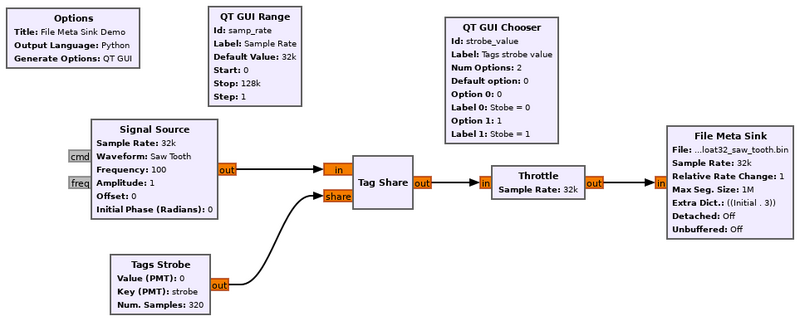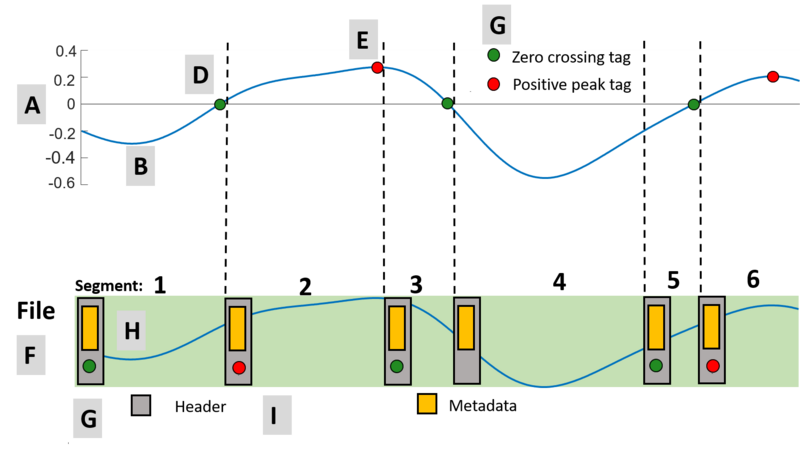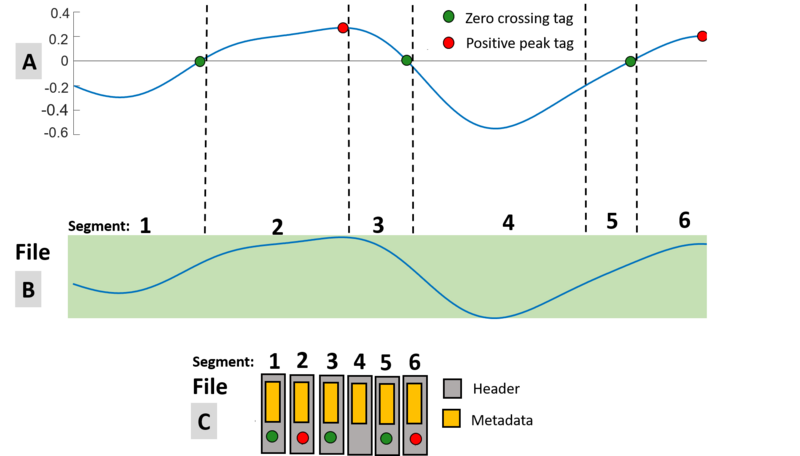File Meta Sink: Difference between revisions
(Added details about how the file is saved) |
|||
| Line 59: | Line 59: | ||
; Block definition | ; Block definition | ||
: [https://github.com/gnuradio/gnuradio/blob/master/gr-blocks/grc/blocks_file_meta_sink.block.yml] | : [https://github.com/gnuradio/gnuradio/blob/master/gr-blocks/grc/blocks_file_meta_sink.block.yml] | ||
== FAQ == | |||
===How is the file organized when it contains an embedded header?=== | |||
A file with an embedded header is created by the file meta sink block is organized into multiple data segments that are sequential. Assume the waveform (Fig 1.A) is being recorded to file. The waveform (Fig 1.B) is converted to a data stream which may be annotated with stream tags [https://wiki.gnuradio.org/index.php/Stream_Tags]. In this example the stream tags indicate both the zero crossings (Fig 1.D) and the positive peaks (Fig. 1.E) of the waveform. Each data segment in the file (Fig 1.F) is composed of a header (Fig 1.G) and the waveform data (Fig 1.H). The header can be further decomposed into metadata and stream tags (Fig 1.I). The metadata consists of information such as a sample rate, absolute position in the stream sequence and data type. The stream tags can indicate any useful feature or information about the data stream. | |||
A new data segment is created when either: | |||
# A stream tag has been written (segments 1,2,3,5, and 6) | |||
# The data segment size maximum has been reached (segment 4). In this segment no stream tags are recorded. | |||
[[File:file_meta_sink_figure_1.png|800px]] | |||
<br> | |||
'''Figure 1: Recording a waveform to a single file with tags''' | |||
===How is the file organized when the header is detached?=== | |||
The waveform (Fig 2.A) is saved in a similar manner as with the embedded header except the data stream (Fig 2.B) and header information (Fig 2.C) are stored in separate files. | |||
[[File:file_meta_sink_figure_2.png|800px]] | |||
<br> | |||
'''Figure 2: Recording a waveform to a data stream file and detached header file''' | |||
file_meta_sink_figure_2.png | |||
Revision as of 21:53, 6 June 2021
Write stream to file with meta-data headers.
These files represent data as binary information in between meta-data headers. The headers contain information about the type of data and properties of the data in the next segment of samples. The information includes:
- rx_rate (double): sample rate of data.
- rx_time (uint64_t, double): time stamp of first sample in segment.
- size (uint32_t): item size in bytes.
- type (::gr_file_types as int32_t): data type.
- cplx (bool): Is data complex?
- strt (uint64_t): Starting byte of data in this segment.
- bytes (uint64_t): Size in bytes of data in this segment.
Tags can be sent to the file to update the information, which will create a new header. Headers are found by searching from the first header (at position 0 in the file) and reading where the data segment starts plus the data segment size. Following will either be a new header or EOF.
Use of the pmt package to specify parameter Extra Dict requires an Import block with import pmt.
Parameters
(R): Run-time adjustable
- File (R)
- Name of file to write data to.
- Sample Rate
- Sample rate of data. If sample rate will be set by a tag, such as rx_tag from a UHD source, this is basically ignored.
- Relative_rate
- Rate chance from source of sample rate tag to sink.
- Max Seg. size
- Length of a single segment before the header is repeated (in items).
- Extra dict.
- A PMT dictionary of extra information. This field is required, and pre-filled as
pmt.make_dict().
- Detached header
- Set to true to store the header info in a separate file (named filename.hdr)
- Unbuffered (R)
- If new samples are flushed to file at the end of each call to the work function
Example Flowgraph
In this example, the file meta sink block is saving both a data stream from the signal source generating a saw tooth waveform and stream tags that align with the start for the saw tooth waveform.

Source Files
- Header files
- [3]
- Public header files
- [4]
- Block definition
- [5]
FAQ
How is the file organized when it contains an embedded header?
A file with an embedded header is created by the file meta sink block is organized into multiple data segments that are sequential. Assume the waveform (Fig 1.A) is being recorded to file. The waveform (Fig 1.B) is converted to a data stream which may be annotated with stream tags [6]. In this example the stream tags indicate both the zero crossings (Fig 1.D) and the positive peaks (Fig. 1.E) of the waveform. Each data segment in the file (Fig 1.F) is composed of a header (Fig 1.G) and the waveform data (Fig 1.H). The header can be further decomposed into metadata and stream tags (Fig 1.I). The metadata consists of information such as a sample rate, absolute position in the stream sequence and data type. The stream tags can indicate any useful feature or information about the data stream. A new data segment is created when either:
- A stream tag has been written (segments 1,2,3,5, and 6)
- The data segment size maximum has been reached (segment 4). In this segment no stream tags are recorded.

Figure 1: Recording a waveform to a single file with tags
How is the file organized when the header is detached?
The waveform (Fig 2.A) is saved in a similar manner as with the embedded header except the data stream (Fig 2.B) and header information (Fig 2.C) are stored in separate files.

Figure 2: Recording a waveform to a data stream file and detached header file
file_meta_sink_figure_2.png